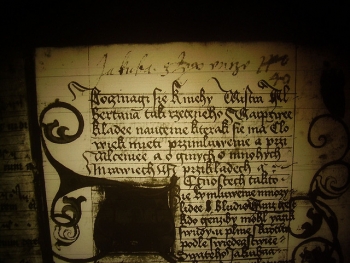Regarding Evidence That The Voynich Manuscript Was Written by Cathars in the Amazon Rainforest

The Yale University Library holds a medieval manuscript written in undecipherable code, in an unknown alphabet, in an unknown language, and it contains detailed drawings of more than one hundred plants none of which have ever been positively identified. Named after a bookseller who purchased it a century ago, the Voynich manuscript has been called the world's most mysterious manuscript.
Scholars think that the Voynich was written somewhere in Europe but it is unknown by whom. The text of the Voynich is of no help in determining authorship since it has never been decoded, and some of the world's best cryptographers have tried. But as the old saying goes, "One picture is worth a thousand words," and the Voynich manuscript is packed full of pictures. From these drawings, I have concluded that the authors of the manuscript were Cathars, a sect of religious heretics that prospered in southern Europe in the 12th and 13th centuries. Specifically, the evidence is as follows:
a) in at least two different places the Voynich depicts Cathar women performing a baptism-like ceremony know as consolamentum, the only sacrament of Catharism. The Cathar Church had no formal clergy so a lay clergy of both sexes was empowered to perform this sacrament.
b) the Voynich depicts the round table of the governing lay clergy of the Cathar Church both in the European winter (mixture of men and women fully clothed) and at a summertime resort (now only naked women sitting in the circle). In sharp contrast to other medieval religions, women played a major role in the Cathar Church.
c) the Voynich depicts a European fortress with a round tower capped in a cone, exactly like the conned towers of the still-extant Carcassonne fortress, which was once a stronghold of Catharism and today is noted for its museum of torture, housing the original equipment used to convince the Cathars to repent.
d) though the underlying alphabetic characters of the Voynich are unknown, the manuscript utilizes recognizable accent marks: three different Voynich accents (the hook accent, the bloop accent, and the crossbar accent) can be found in the Homilies d'Organya, a manuscript of the old Catalan language, that is, a member of the Occitan family of languages spoken by the Cathars.
e) some of the women in the Voynich are depicted wearing an unusual top-of-the-head hair style, the same hair style seen in Europe in a medieval painting that depicts the Cathars being expelled from Carcassonne.
Moreover, please note that because of severe persecution by the Inquisition, the Cathars, more than any other people of medieval Europe, would have had a need to write in code. The Inquisition burned all the Cather literature that they could lay their hands on, so it unknown if, once upon a time, there were other manuscripts written in the Voynich script.
Radiocarbon experts from the University of Arizona have dated the Voynich manuscript to the early 15th century, between AD 1404 and AD 1438, which gives us a great anomaly. The Cathars --all half million of them-- are believed to have become extinct by the early 14th century, wholly eliminated by the papal Crusades and Inquisition torture chambers. There were no known survivors except for reports that a handful of Cathars escaped the massacre at Montsegur in AD 1244, carrying with them the sacred relic of their faith. Apparently, neither these escapees nor their treasure (believed by some to be esoteric texts or the Holy Grail) were ever found.
The mystery compounds itself when we observe that no European botanist has ever identified any of the more than one hundred plants depicted, in great detail, in the Voynich manuscript. This raises suspicions that perhaps these are not plants of Europe after all but of some other place. Given the enormous diversity of exotic plants depicted in the manuscript, one place that quickly comes to mind is the Amazon rainforest of South America. This could also explain all the naked women seen in the Voynich manuscript, i.e. the survivors of Montsegur moved to the tropics where clothing was not particularly necessary.
I was elated when I found a picture of an Amazon plant with pointed green leaves and bunches of red berries that looked just like one of the Voynich plants, but then I discovered that similar plants exist elsewhere. The Voynich, however, has some extremely peculiar plants, so much so that they are suspected of being purely fictional concoctions. One such plant can be found between pages numbered 2 and 3 in the Yale PDF file, which is available online. I found a modern photograph of that plant and acquired rights to post it on my website, where I am currently awaiting the opinion of professional botanists on whether or not it is the exact same species.
It is doubtful that this plant --a tropical underwater plant of odd shape with one floral offshoot but lacking branches and leaves-- could even survive in Europe let alone be found there. Whether by disease, headhunters, or perhaps intermarriage with the natives, any Cathar settlement in the Amazon rainforest did not survive to see the arrival of the Conquistadors, but the Voynich manuscript nonetheless raises the intriguing possibility that the French Cathars beat the Spanish to the Americas by more than two hundred years.
